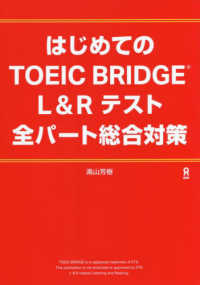- ホーム
- > 洋書
- > 英文書
- > Science / Mathematics
Full Description
In this volume algorithms are compared for rhumb line sailing (RLS) and great elliptic sailing (GES) calculations commonly used for route planning and route monitoring. Compact vector formulas are given for the great circle and rhumb line on the sphere and rhumb line, great circle, great ellipse and geodesic line on the spheroid providing vector solutions to both the forward and the inverse problems and conversions of longitude and latitude. The solution incorporates a closed form for the azimuth and the derivation of this equation is presented and illustrated. This handbook also shows that a computer algebra system and linear algebra are powerful tools to solve some mathematical derivations that may be useful in navigation, geodesy, and cartography.The book demonstrates the manufacturers of ECDIS systems and GNSS receivers a wide spectrum of solutions possible to use in their algorithms from very simple (on the flat or on the sphere) to very complicated (on the surface of ellipsoid).
Contents
1 Loxodromic Navigation1.1 Rhumb Line1.2 LoxodromesGo1.3 Rhumb Line Sailing RLS Algorithms1.4 Loxodromic Navigation1.5 Practical Sailing Formulas for Rhumb Line Tracks on an Oblate Earth1.6 Practical Rhumb in Calculations on Spheroid1.7 Direct and Inverse Solutions with Geodetic Latitude in Terms of Longitude for Rhumb Line Sailing2 Great Circle Navigation2.1. Great Circle2.2. Great Circle Equation - Novel Approach to Great Circle Sailings2.3. Approximation models of orthodromic navigation2.4. Sailing in Ever-Decreasing Circles3 Vector Solutions3.1. Vector Solutions for Great Circle Navigation3.2. Great Circle Navigation with Vectorial Methods3.3. Vector Function for Distance Travelled in Great Circle Navigation3.4. Earle's Vector Solutions for Azimuth4 Great Ellipse Navigation4.1. Great ellipse on the surface of the spheroid4.2. New Algorithm for Great Elliptic Sailing (GES)4.3. Vector Solution for Navigation on a Great Ellipse4.4. Accurate Harmonic Series for Inverse and Direct Solutions for the Great Ellipse5 Geodesic Line on the Surface of a Spheroid5.1. Geodesic Line5.2. Vincenty's Direct and Inverse Solutions of Geodesics on the Ellipsoid with Application of Nested Equations5.3. Geodesics on an Ellipsoid - Pittman's Method5.4. Navigating Along Geodesic Paths on the Surface a Spheroid6 Comparisons and Modifications of Sailing Calculations6.1. Sphere to Spheroid Comparisons6.2. Hiraiwa's Proposal on the Modification of Sailing Calculations6.3. Geodetic Inverse Solution Between Antipodal Points6.4. Shortest Distance Between Two Nearly Antipodean Points on the Surface of a Spheroid7 Great Elliptic Arc Distance - Deakin's Approach7.1. Introduction7.2. Equation of a Great Elliptic Arc Section7.3. The Vertex of the Great Elliptic7.4. Geometric Parameters of the Great Elliptic7.5. The Azimuth ホア of the Great Elliptic7.6. The Azimuth ホア of the Great Elliptic - Thomas' Approach7.7. Great Elliptic Latitudes7.8. The Auxiliary Sphere and the Great Elliptic7.9. Relationship Between Azimuth ホア1 and Spherical Azimuth A17.10. The Direct Problem on the Ellipsoid Using a Great Elliptic7.11. The Inverse Problem on the Ellipsoid Using a Great Elliptic7.12. Difference in Length Between a geodesic and a Great Elliptic Arc LengthAppendix 1: VectorsAppendix 2: Taylor's TheoremAppendix 3: Revision of a Series8 Rhumb Line, Great Circle and Great Ellipse in ECDIS8.1. Map Projections and Visualisation of Navigational Paths in Electronic Chart Systems8.2. Geodetic or Rhumb Line Polygon Area Calculation Over the WGS-84 Datum Ellipsoid8.3. New Meridian Arc Formulas for Sailing Calculations in Navigational GIS8.4. Conclusions9 Final Conclusions - An Attempt of Generalization and Indicating the Directions for Further ResearchReferences








